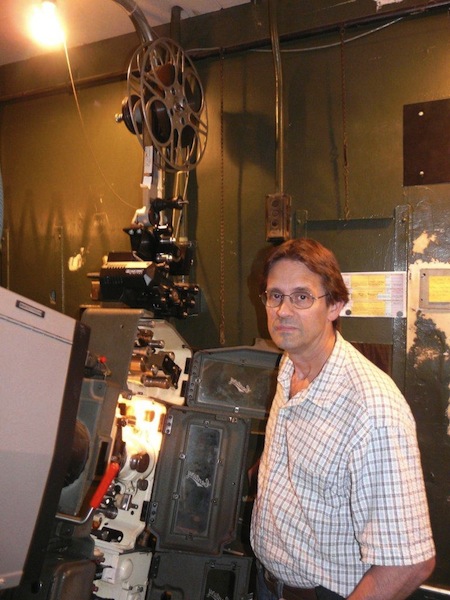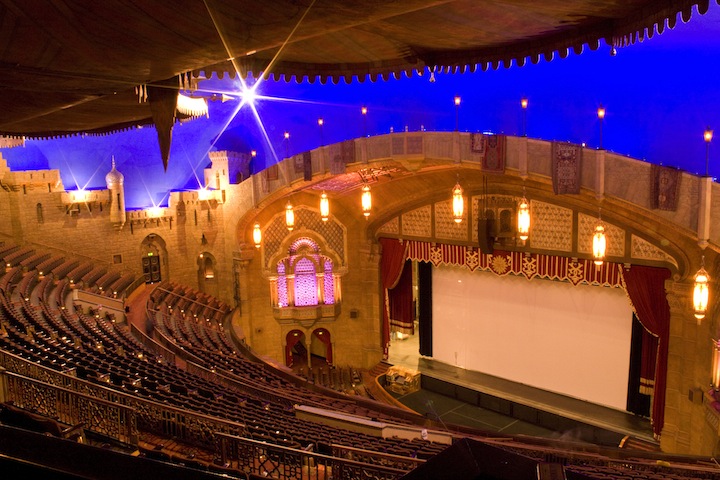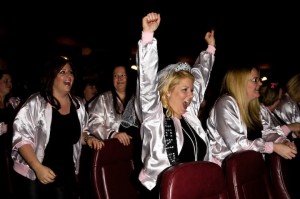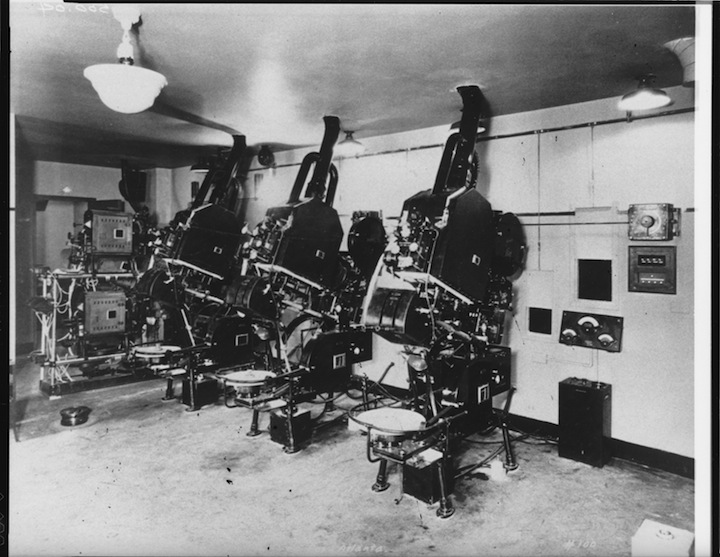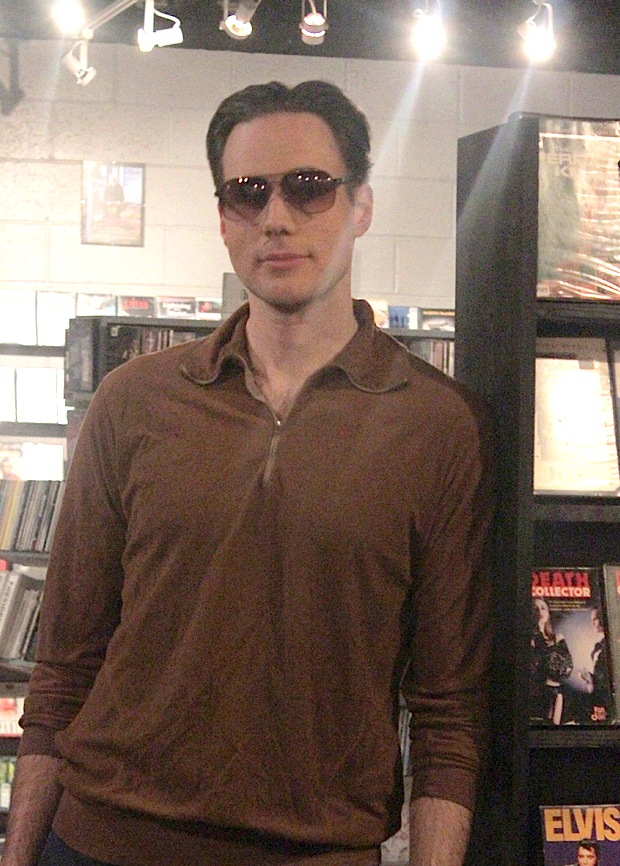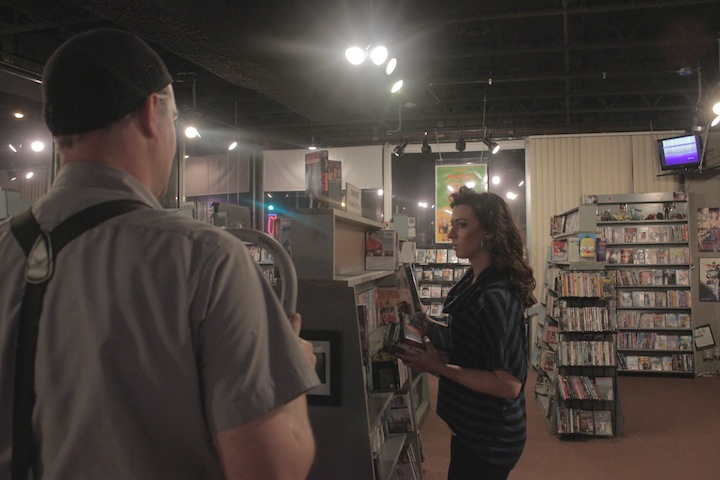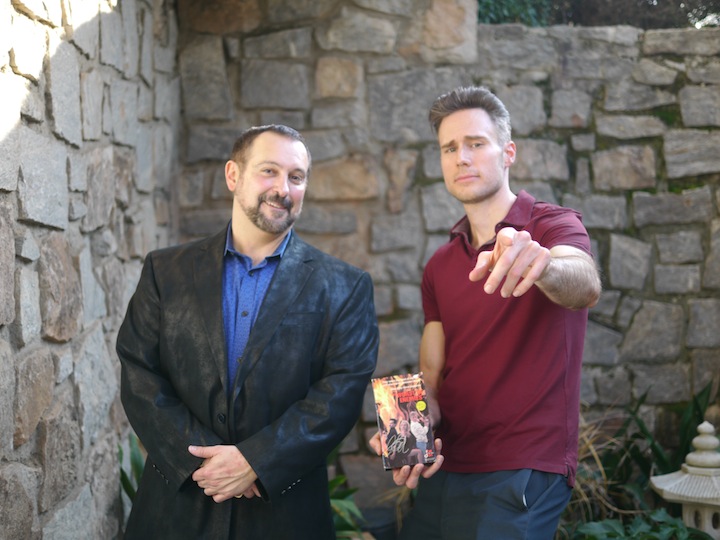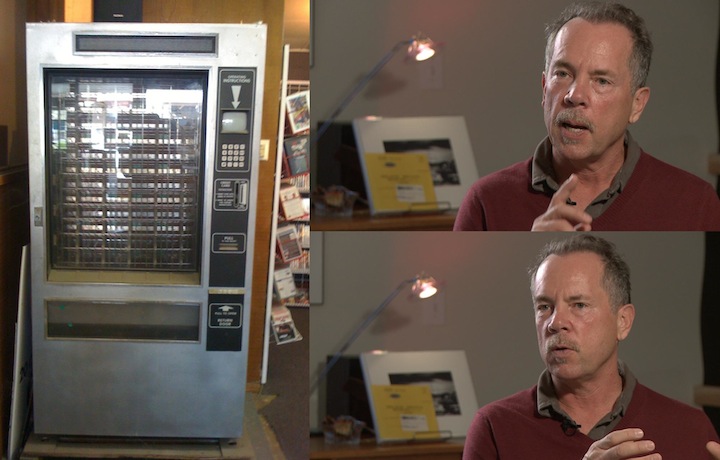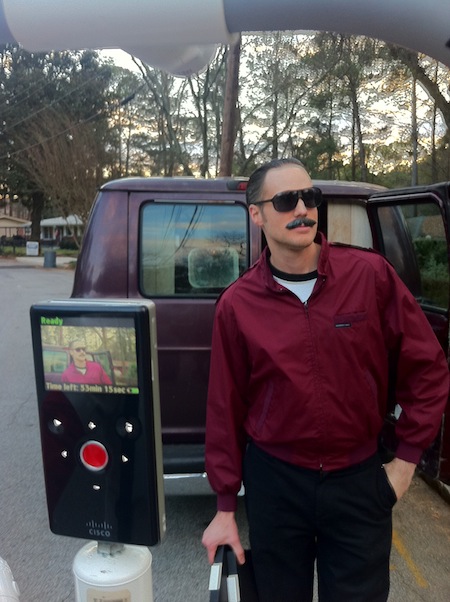by Melanie Crew
Managing Editor
Justin Bozung, Atlanta author and transplant from the far reaches of the north is working closely with Videodrome staff as they present their Frank Perry Retrospective via their JavaDrome film portal, which kicked off in January 2017. The most recent in the series, THE SWIMMER (1968) screens Friday, March 31, at 8:30pm, and will include an introduction and Q&A with Bozung, as Frank Perry’s official biographer. Prior films in the series included MOMMIE DEAREST (1981); PLAY IT AS IT LAYS (1972) [never released on home video]. The series’ finale will be Perry’s LAST SUMMER (1969) screening in late April 2017 [yet to be released beyond its ‘80s VHS release].
Bozung has an expansive resume delving deep into the retro fantastic! He’s assisted in book projects documenting and analyzing Stanley Kubrick, has conducted over 400 interviews for several book projects, documentaries and magazines including Fangoria, Paracinema, Phantom of the Movies’ Videoscope and more. ATLRetro caught up with Justin Bozung for a quick interview about his work as the official biographer for Frank Perry, his extensive knowledge of Stanley Kubrick’s THE SHINING and Norman Mailer, and the importance of preserving film history.
ATLRetro: While we are a bit biased here at ATLRetro about this wacky little city of ours, what is it about Atlanta that drew you to our neck of the woods?
 Justin Bozung: My wife! She received a job opportunity that was too good to pass up. So we sold our house and packed up in Ann Arbor, Michigan in late 2014 and drove toward Atlanta. As a freelancer, I’m pretty open-ended and am able to work from anywhere so it made sense for us to leave the cold and snow behind. And I’ve always been fond of Georgia; having spent some time here over the years during various travels and vacations in the south. I’m a big soul, funk, and jazz music fan. So being able to come and live where Curtis Mayfield had his own record label, but also, be within driving proximity of where James Brown was born and lived many years of his professional life and owned his own radio station is great. Central Georgia also owns The Allman Brothers and Otis Redding—so living in the South is really a soul music lover’s dream come true! Memphis, the home of the great Stax Records, isn’t too far away either. And I’m completely fine–I’m not ashamed–in saying that as a Michigan-born guy, I’ll take Memphis and Stax Records any day of the week over anything produced at Detroit’s Motown. There’s something about the water down here that gives the music a special quality, something that Motown doesn’t have that Stax does... And let’s not even get started on the subject of Athens, Georgia and R.E.M.–
Justin Bozung: My wife! She received a job opportunity that was too good to pass up. So we sold our house and packed up in Ann Arbor, Michigan in late 2014 and drove toward Atlanta. As a freelancer, I’m pretty open-ended and am able to work from anywhere so it made sense for us to leave the cold and snow behind. And I’ve always been fond of Georgia; having spent some time here over the years during various travels and vacations in the south. I’m a big soul, funk, and jazz music fan. So being able to come and live where Curtis Mayfield had his own record label, but also, be within driving proximity of where James Brown was born and lived many years of his professional life and owned his own radio station is great. Central Georgia also owns The Allman Brothers and Otis Redding—so living in the South is really a soul music lover’s dream come true! Memphis, the home of the great Stax Records, isn’t too far away either. And I’m completely fine–I’m not ashamed–in saying that as a Michigan-born guy, I’ll take Memphis and Stax Records any day of the week over anything produced at Detroit’s Motown. There’s something about the water down here that gives the music a special quality, something that Motown doesn’t have that Stax does... And let’s not even get started on the subject of Athens, Georgia and R.E.M.–
As Frank Perry’s official biographer, can you tell our readers a little about why you think he is one of the many undervalued and underappreciated filmmakers and why you wanted to spread the Frank Perry love via Videodrome’s JavaDrome film events?
Well, there’s a pretty easy answer to that. The internet is interested in Frank Perry. Fortunately, today, with the rise of social media and bloggers pulling active duty–interest in Perry and his films has really grown in recent years. He made some really wonderful films, and it’s important to note that Perry was the first independent filmmaker to be nominated for an Academy Award. He was nominated in 1963 for his independently-financed and produced DAVID AND LISA (1962), which shot for approximately $200,000 in Pennsylvania. Perry was nominated for Best Director but he lost out to David Lean, who won for LAWRENCE OF ARABIA (1962)! Perry’s little film went up against LAWRENCE! Jean Renoir, said “I feel that this film represents a turning point in the history of film.”
Prior to  Perry, where there had certainly been others producing independent films on the East Coast– John Cassavetes‘s SHADOWS (1959) being the touchstone–others like Russ Meyer and his THE IMMORAL MR. TEAS (1959), and H.G. Lewis in Chicago with his “nudie cuties” were also bringing independent film to attention. Perry was the first to make a “respectable” independent film and to be noticed by the mainstream. In his way, he changed things. Even with someone like Cassavetes, who by 1959 was a well-known and very established Hollywood film actor–his film SHADOWS still didn’t afford the average guy the idea that maybe he himself could just go out and raise the money and make his own film as a profiteer. Perry had no experience as a filmmaker, really. On the first day of shooting DAVID & LISA, he couldn’t figure out how to turn the camera on. And in pre-production he read several books about film directing. His film school was the library. It really makes one remember what was going on in independent film in the late 80s or early 1990s with directors starting out like Robert Rodriguez. While Perry had come from the Actors Studio and done some Second Unit work for hire prior, he had not really directed anything on that scale before. His gift was in working with actors. I consider him a conscious, classical director. He worked very much like George Cukor who loved working with actresses and literary adaptations. Frank set the wheels on fire and got indie film some important notice in Hollywood. DAVID & LISA made the studio system, although on the verge of completely crumbling, sit up and take notice that things were shifting culturally.
Perry, where there had certainly been others producing independent films on the East Coast– John Cassavetes‘s SHADOWS (1959) being the touchstone–others like Russ Meyer and his THE IMMORAL MR. TEAS (1959), and H.G. Lewis in Chicago with his “nudie cuties” were also bringing independent film to attention. Perry was the first to make a “respectable” independent film and to be noticed by the mainstream. In his way, he changed things. Even with someone like Cassavetes, who by 1959 was a well-known and very established Hollywood film actor–his film SHADOWS still didn’t afford the average guy the idea that maybe he himself could just go out and raise the money and make his own film as a profiteer. Perry had no experience as a filmmaker, really. On the first day of shooting DAVID & LISA, he couldn’t figure out how to turn the camera on. And in pre-production he read several books about film directing. His film school was the library. It really makes one remember what was going on in independent film in the late 80s or early 1990s with directors starting out like Robert Rodriguez. While Perry had come from the Actors Studio and done some Second Unit work for hire prior, he had not really directed anything on that scale before. His gift was in working with actors. I consider him a conscious, classical director. He worked very much like George Cukor who loved working with actresses and literary adaptations. Frank set the wheels on fire and got indie film some important notice in Hollywood. DAVID & LISA made the studio system, although on the verge of completely crumbling, sit up and take notice that things were shifting culturally.
On March 31, JavaDrome will screen Perry’s The Swimmer (1968). Were there any particular reasons you chose the films that are slated for screening?
Well, the guys at Videodrome split the selections down the middle for this retrospective on Perry’s films. I hand-picked two and Matt Owensby picked the others. THE SWIMMER was a film that Matt really wanted to show as part of this retrospective. It should be stated that this retrospective on Perry’s films here in Atlanta marks the first multi-film retrospective of his work in the USA since the mid 1980s. In fact, I can’t help but suggest that the recent Los Angeles retrospective of his work last month, put on by Quentin Tarantino at his New Beverly, was directly inspired by our own little retrospective here in Atlanta–knowing how Tarantino seemingly likes to monitor video stores all around the United States and see what they’re up to.
Videodrome is our little purveyor of the forbidden fruits of the video and film world and are avid supporters of film preservation, which of course is why they hold a sweet spot in our hearts. As a historian, can you tell our readers a little bit about why you think film preservation is important and how important businesses like Videodrome are to the preservation of film?
I’m just starting to get acquainted with a few of the guys that work at Videodrome. The fun part about going into the store is that they really have a massive selection of titles, but more importantly, Matt and John and the rest of the crew really embrace you. And they’re not elitist or snobs either. They care about and endorse the films of Truffaut just as much as they love and admire the films of Greydon Clark. The latter–preservation, is important as well,  certainly. I’ve been struggling with that myself working with Frank Perry’s Estate. Frank made two films that are impossible to see. The first, I recently discovered the master materials for in an archive in California. We’re talking with some film preservation folks now about financing the restoration of one of these, his JFK: ONE MAN SHOW (1984)–which was made and shown on PBS twice before vanishing off the face of the earth, it seemed until I located it. And then there’s his 1968 documentary that Perry fans aren’t even aware of that he made about political unrest in the Middle East, because it’s mysteriously not listed on his IMDb page. The Estate has access to the last print that is known to exist. Just to use these two instances as an example, if there weren’t people “out there” tracking down films or storing prints or whatever–archiving cinema–we may all lose out in the future. So it’s the key to film studies, really.
certainly. I’ve been struggling with that myself working with Frank Perry’s Estate. Frank made two films that are impossible to see. The first, I recently discovered the master materials for in an archive in California. We’re talking with some film preservation folks now about financing the restoration of one of these, his JFK: ONE MAN SHOW (1984)–which was made and shown on PBS twice before vanishing off the face of the earth, it seemed until I located it. And then there’s his 1968 documentary that Perry fans aren’t even aware of that he made about political unrest in the Middle East, because it’s mysteriously not listed on his IMDb page. The Estate has access to the last print that is known to exist. Just to use these two instances as an example, if there weren’t people “out there” tracking down films or storing prints or whatever–archiving cinema–we may all lose out in the future. So it’s the key to film studies, really.
You also collaborated with Colorado’s Centipede Press in putting together a large volume entitled Stanley Kubrick’s The Shining: Studies in the Horror Film. Can you tell our readers what role you played in the process? Did you learn anything enticing with this publication that isn’t common knowledge about Kubrick or The Shining?
The book came out in the early spring of 2015 and sadly, it’s already out of print, I believe. It was a massive 750-page book on the making of the film. I was involved with the book, as a project, very early on, researching and getting clearances for many of the previously-published essays and interviews that are included. I also dug up some visual ephemera, and conducted about 45 hours of interviews with most of the cast and the crew from the film itself—which are all included in the book. I interviewed or was in touch with the entire crew and most of the living actors that starred in the film. The book was edited by Danel Olson, but, 350-400 or so of those 750 pages are my contributions to the volume. The book is filled to the brim with new information about Kubrick–things that people didn’t know about him and the film itself including line items about his attention to detail, his admiration for  baseball, his love of driving cars fast and more. There’s information in the book about what went on behind-the-scenes of the film that has never come to light prior and addresses his notorious reputation, but also looks at his craftsmanship. It’s page-after-page with new information on Kubrick. I tried to debunk many rumors that have been swirling around in the zeitgeist for many years about Kubrick and I used the interviews in an attempt to give readers a doorway onto the set in England for 13-months back in 1978/79. When it came out, ROOM 237 was really on everyone’s lips–so there’s a lot of talk in the book about that documentary as well. It’s a great book, though. I’d suggest that it’s an essential addition to any film lover’s library. Michael Dirda of The Washington Post called the book “a major advancement in film studies,” or something like that.
baseball, his love of driving cars fast and more. There’s information in the book about what went on behind-the-scenes of the film that has never come to light prior and addresses his notorious reputation, but also looks at his craftsmanship. It’s page-after-page with new information on Kubrick. I tried to debunk many rumors that have been swirling around in the zeitgeist for many years about Kubrick and I used the interviews in an attempt to give readers a doorway onto the set in England for 13-months back in 1978/79. When it came out, ROOM 237 was really on everyone’s lips–so there’s a lot of talk in the book about that documentary as well. It’s a great book, though. I’d suggest that it’s an essential addition to any film lover’s library. Michael Dirda of The Washington Post called the book “a major advancement in film studies,” or something like that.
We see that you’re also involved with author Norman Mailer’s estate and that you work on several projects dedicated to him. What can you tell us about those projects?
I become involved with Norman Mailer in early 2014 and made a 12-hour audio documentary about his much-maligned 1987 film, TOUGH GUYS DON’T DANCE, my favorite film. I interviewed most of the crew members and some of the actors and visited some of the shooting locations in Provincetown, MA. My interest in the film came out of my friendship with TOUGH GUYS actor, Wings Hauser. He first introduced me to the film in 2011, when I was about to interview him for a magazine. The documentary was released online, and the Norman Mailer Society invited me to talk about the film in the fall of 2014 at Wilkes University. Shortly after that, they asked me to become involved in several projects that they were working on. One was Project Mailer, and another was archival search-related. I created a Mailer podcast for them, which runs bi-monthly on ProjectMailer.net. Basically, I just present audio from the Mailer Archives ala podcast format ala the old Grateful Dead Hour with David Gans. In  early 2015, I started putting together a dense, academic study on Mailer’s films.
early 2015, I started putting together a dense, academic study on Mailer’s films.
He made 6 films from 1947-1987. I love his films, even though, most of the Criterion Collection audience doesn’t. Criterion released Mailer’s 1960s films through their Eclipse series in 2013. They scratch their heads as to why CC would put out such “awful” films. They’re very important works of art that not only comment and inform on Mailer’s influential texts of the 1960s, but also, in their way, influenced his writing in the process of crafting them. They also have historical context in relationship to the direct cinema movement of the mid 60s with films by D.A. Pennebaker and the Maysles Brothers. There, likely, may never have been an ARMIES OF THE NIGHT without WILD 90 (1968), for example. Mailer wrote himself into that book as a character–in the third person–directly out of the influence that the editing of his first film, WILD 90, had upon him while he was writing that Pulitzer Prize-winning “novel as history, history as novel”–to use Mailer’s description. He said, and I’m paraphrasing, “I was looking at myself as a character,” during the editing of his own movie.
His film MAIDSTONE (1971) is a obvious pre-cursor to reality television. I certainly do not lay the blame on reality television on Mailer, but he was creating that type of aesthetic tension and propaganda–and recording it–on film, some thirty years before reality television came along. Cinema was in Norman Mailer’s blood. He had a keen interest in cinema, and a fine grasp of cinema aesthetics very early on in his life–before he became the writer enfant terrible of the 1960s that many remember him as today. He was a frequent guest at Amos Vogel‘s legendary Cinema 16 in New York City. He saw the films of Brakhage, Kenneth Anger, Warhol, Mekas there. He helped to fund the films of Robert Downey Sr. and Ron Rice. Mailer’s writing is profoundly cinematic, and the cinema is one of his strongest and most-used metaphors in his writing and it’s throughout his texts. His ideas on film are really in sync with filmmakers that would be his peers of the era. My book, The Cinema of Norman Mailer: Film is Like Death comes out this September via Bloomsbury. It’s available for pre-order on Amazon now. And this September I’m starting work and collaborating with the Mailer Estate on another book on Mailer, but this time around, it’s about the writer, not Mailer: The filmmaker.
the writer, not Mailer: The filmmaker.
As a film buff and historian, what was your gateway drug into the land of cult film, or film in general?
I’ve always been interested in film, for as long as I can remember. I grew up as a classic, indoor-type of kid. I grew up in the VHS and pay cable era of the 1980s. My parents gifted me with HBO, Cinemax, and Showtime. I recorded everything off and watched it over-and-over. Film has always been very important to me as an art form. I love all film. I don’t pay attention to genres or labels. Film is film. There aren’t any “good” or “bad” films, just films. I love Larry Buchanan, Michael Bay just as much as I do Delbert Mann, King Vidor and Jerry Lewis.
You’ve also published several articles and interviews in magazines such as “Fangoria,” “Paracinema,” “Shock Cinema” and “Phantom of the Movies’ Videoscope.” If you had to choose a favorite interview and/or article that you contributed, which would it be and why?
I’ve done a lot of interviews over the years. I think around 400 or so. I may be the only person you’ll meet who has done over 75 interviews with various crew and cast members from several Stanley Kubrick movies, hundreds of hours logged, and all on tape. I imagine myself as being in the Guinness Book of Work Records under “Most Interviews Done Associated with Stanley Kubrick.” My favorite though….I have two. The first was with actor Wings Hauser, because we became great friends out of the experience. The other is with comedy legend and screenwriter Bill Richmond. Richmond wrote almost all of the Jerry Lewis solo movies like THE PATSY (1964) and THE NUTTY PROFESSOR (1963). He wrote for TV shows like The Carol Burnett Show, Bewitched, All in the Family, Welcome Back, Kotter, Blossom etc… He was a mad genius of comedy. It was just one of those great one-in-a-lifetime  experiences, where, consequently, we stayed friendly with each other after it was over. Bill sent me the best birthday present the year after even…and when he passed away last year—that was really sad for me.
experiences, where, consequently, we stayed friendly with each other after it was over. Bill sent me the best birthday present the year after even…and when he passed away last year—that was really sad for me.
Can you tell our readers a little about your Frank Perry biography and any other current projects your working on, and where our readers get their hands on your published works?
The biography on Frank will be published mid-2018 and is a full-scale biography blended with some analysis. I’m finishing it up now. I’ve been working on it since early 2015, but there was a full year where I didn’t work on it at all, due to some legal tangle with his Estate and an outside party. It is the first book, first study on Perry. I’ve been working closely with Perry’s family and estate on the project and I worked closely with his wife, Barbara, before her recent passing. But also, Tom Folino, Perry’s long-time friend, assistant-turned producer. I’m in touch with his surviving family members and as with all of my projects, I’ve got about 200-hours of interviews in the can with various crew members and actors, family friends in support of the work itself. The book looks at Perry’s life and his films, but also looks closely at the projects that slipped through the cracks–like his near adaptation of Terry Southern‘s naughty-satire novel Candy which looked like it was going to be made as early as 1964 into a film. This, of course, lead to Perry making of THE SWIMMER, but I’ll talk about how that all happened this Friday at the screening with Videodrome. Your readers can find all of my work on Amazon here. This year I also expect to finish up an academic volume on Michael Bay, called Michael Bay: High Art / Low Culture.
Do you have any advice for those writers just starting out?
Quit wasting time on Facebook. Write every day. Research and research. When you think you’ve found everything. Stop. Then wait 2 weeks and research some more. You’ll always find something extra. If you say you’re going to write tomorrow, then you better do that. Don’t put it off, because it damages your unconscious, and that’s where all the words come from–from inside of you. Don’t piss off your unconscious. Don’t write anything for free. Your time is valuable. Writers should say something new; they need to formulate new and profound ideas. So do that. And last but not least, opinions are so very rarely ideas.
Can you give us five things you’re into at the moment that we should be reading, watching or listening to right now—past or present, well-known or obscure?
Well, I’m more of a reader than I am anything else these days. I read one magazine currently–Philosophy Now. It’s my favorite. Some things I’ve enjoyed tremendously this year so far would be Ernest Hemingway: A Life Story by Carlos Baker. It was published in 1968 and it’s probably the greatest biography ever written; Free Fall by William Golding –a classic, but undervalued work of existential literature; Jurgen by James Branch Cabell — one of Margaret Mitchell‘s favorite novels published in 1919; Margaret Mitchell: Reporter reprints Mitchell’s pre-Gone with The Wind Atlanta  journalism; Claire Vaye Watkins‘s Battleborn–a fresh, newer voice in short fiction with family ties to The Manson Family; Altamont, Joel Selvin‘s incredible recounting of the dark, metaphysical Rolling Stones 1969 Atlamont music festival; and Manly Health and Training by Walt Whitman. As far as music goes I’m really a jazz and soul guy, so anything by John Coltrane. My favorite Coltrane record is GIANT STEPS although I’m very attracted to his metaphysical explorations like ASCENSION. Anything Sun Ra. Sonny’s album NUCLEAR WAR is relevant with today’s political climate. His writings are wonderful as well. James Brown‘s REVOLUTIONS OF THE MIND, the new Otis Redding: The Complete Whiskey A Go Go Shows Box Set is always on my stereo or phone! Films I’m currently into are Michael Bay’s Director’s Cut of PEARL HARBOR (1999) shows Bay in his Abel Gance-meets-John Ford glory. Vincente Minnelli’s TEA AND SYMPATHY (1955), Paul Morrissey‘s 1980s trifecta: FORTY DEUCE (1982), MADAME WANG’S (1981), and MIXED BLOOD (1984) are important works. Morrissey is the last great absurdist of the 20th century. Paul and I have talked some over the last couple years about doing a book together, and I would love to do a book on Morrissey, but he’s too cantankerous. Melvin Van Peebles’ THE STORY OF A THREE-DAY PASS (1968), James Bridges’ MIKE’S MURDER (1984) are masterpieces, and PICASSO: MAGIC, SEX & DEATH, a 4-hour 2001 documentary is a must-see!
journalism; Claire Vaye Watkins‘s Battleborn–a fresh, newer voice in short fiction with family ties to The Manson Family; Altamont, Joel Selvin‘s incredible recounting of the dark, metaphysical Rolling Stones 1969 Atlamont music festival; and Manly Health and Training by Walt Whitman. As far as music goes I’m really a jazz and soul guy, so anything by John Coltrane. My favorite Coltrane record is GIANT STEPS although I’m very attracted to his metaphysical explorations like ASCENSION. Anything Sun Ra. Sonny’s album NUCLEAR WAR is relevant with today’s political climate. His writings are wonderful as well. James Brown‘s REVOLUTIONS OF THE MIND, the new Otis Redding: The Complete Whiskey A Go Go Shows Box Set is always on my stereo or phone! Films I’m currently into are Michael Bay’s Director’s Cut of PEARL HARBOR (1999) shows Bay in his Abel Gance-meets-John Ford glory. Vincente Minnelli’s TEA AND SYMPATHY (1955), Paul Morrissey‘s 1980s trifecta: FORTY DEUCE (1982), MADAME WANG’S (1981), and MIXED BLOOD (1984) are important works. Morrissey is the last great absurdist of the 20th century. Paul and I have talked some over the last couple years about doing a book together, and I would love to do a book on Morrissey, but he’s too cantankerous. Melvin Van Peebles’ THE STORY OF A THREE-DAY PASS (1968), James Bridges’ MIKE’S MURDER (1984) are masterpieces, and PICASSO: MAGIC, SEX & DEATH, a 4-hour 2001 documentary is a must-see!
And last, but not least, care to share anything that our little world of Atlantans don’t know about you already?
I don’t want to share anything else about myself, but I would like to suggest this little hiding spot out in Smyrna, Georgia that I visited recently. A restaurant called Vittles. It’s a hole-in-the-wall restaurant that still allows patrons to smoke inside while you sit there eating. Not that I’m standing up for smoker’s rights here, but it’s cancerously-nostalgic. It’s like stepping into a small-town diner in the early 1980s. You can get 4 massive buttermilk pancakes covered in butter, two huge deep-fried pork chops in corn flake crust, and two eggs scrambled all for $6.99. Their claim to fame is their gift shop, which is basically a garage sale that is going on every day concurrently while food is being served. You can buy cement statues of dogs and “Man with No Name” poncho sweaters. It’s a pretty awesome place that I highly suggest visiting for the delicious food and the bargains. You can fill up and then spend a few hours huffing it over on the Silver Comet Trail which runs from Smyrna to well into Alabama. Forget about Krog Market or Ponce, Vittles is where you need to go!
Photos courtesy of Justin Bozung and used with permission.

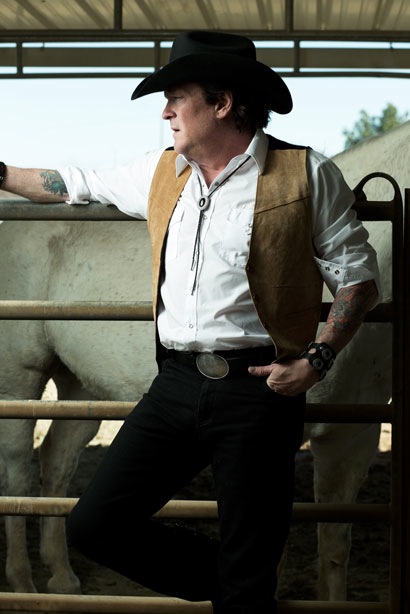
 Is there any previous classic western movie to which it could easily be compared?
Is there any previous classic western movie to which it could easily be compared?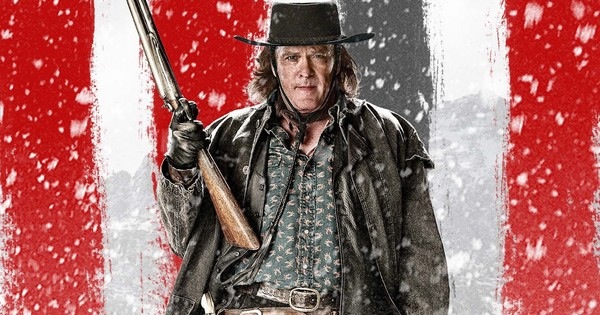

 You were crammed into the tiny backseat of that Chevy Camaro for much of the time.
You were crammed into the tiny backseat of that Chevy Camaro for much of the time.  Or
Or 




